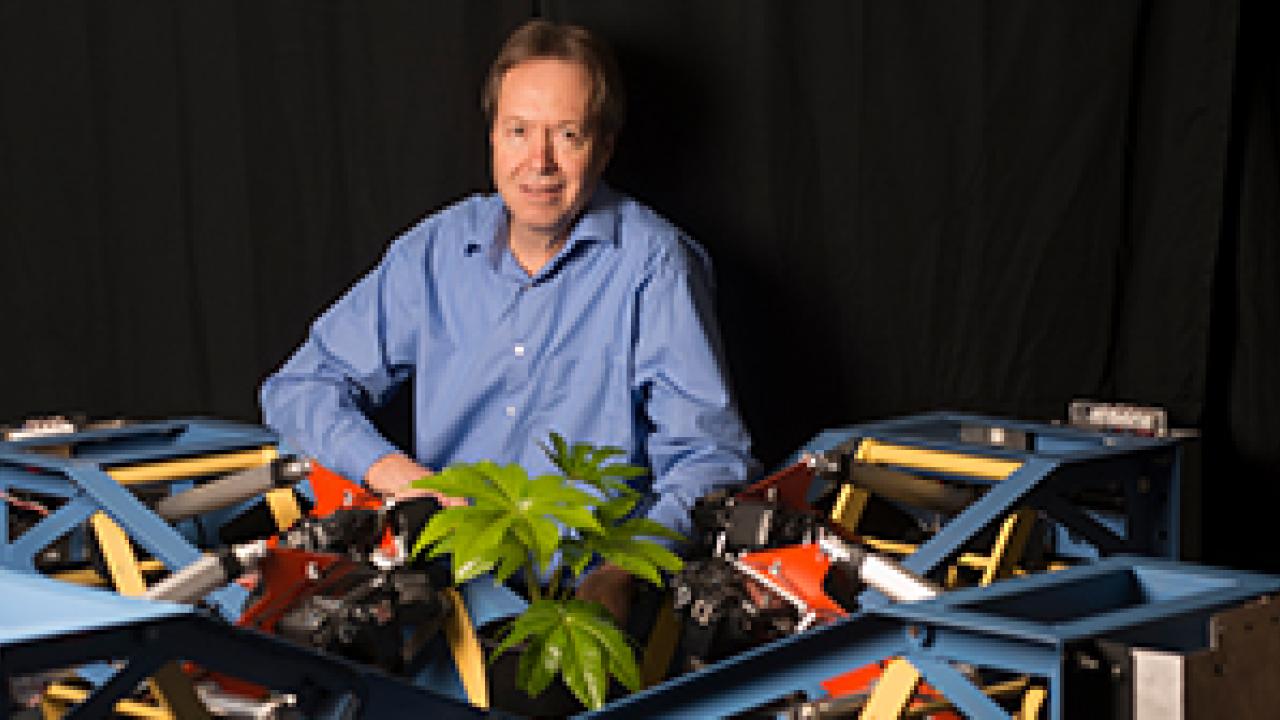
Breeding Resilience
Researchers accelerate crop breeding to keep pace with changing climate
Variable weather is creating extreme challenges for crop breeding in California. How do you develop crops that will thrive under certain conditions when you can no longer predict what those conditions will be?
“It’s the question we’re all asking,” said Charlie Brummer, professor and director of the UC Davis Plant Breeding Center. “Our weather patterns are changing so fast, affecting everything from soil composition to what to expect in terms of weeds, diseases, and pests. It can take 10 years to develop a new crop variety, even more for perennial plants. So we have to extrapolate what the future will bring—very, very quickly.”
Changes have already begun, according to Allen Van Deynze, director of research at the UC Davis Seed Biotechnology Center. A spike in insects and the viruses they transmit are threatening vegetable crops in California and beyond.
“An extra four-to-six weeks of heat can produce another generation of aphids and wipe out an entire crop,” Van Deynze explained. “The insects are multiplying very fast.”
Extreme variations in localized weather pose a bigger challenge to breeders than long-term climate shift. If you know weather will trend hotter, you can plan for that. It is the wild swings—the longer droughts and more intense floodings—that are tricky.
“The insects, weeds, and other pests that thrive in more humid settings are different from those you find during drought,” Brummer said. “We’re working to breed crops that can adapt to it all.”
Breeders and engineers at UC Davis are helping crops keep pace with variable weather by using advanced genetic strategies, developing robotic sensors to measure plant performance, and training the next generation of plant breeders.
Time-lapse evolution
UC Davis breeders help develop new cultivars, or varieties, of the nearly 400 fruits, vegetables, nuts, grains, and ornamentals grown year-round in California’s diverse environments. To create a winning variety, breeders cross plants with desired traits and select the best offspring over multiple generations. That is essentially how humans have been improving crops since the dawn of agriculture 10,000 years ago.
But breeding has become faster and smarter, thanks to rapid improvements in DNA sequencing and the computer power to analyze a wealth of genetic data.
Some plant traits, such as flavor and size, are determined by many genes acting together. Other traits, such as resistance to a disease, may be regulated by a single gene. Breeders can now identify genes that influence some traits at the molecular level, so they can select plants at the seed or seedling stage based on their DNA sequence rather than wait for traits to express themselves as the plants mature. That speeds up the process.
“We have the tools to respond quickly to disease and other threats,” Van Deynze said. “We’re hoping to reduce the time it takes to breed for disease resistance from 8 years to 2 or 3 years.”
The next frontier: fast phenotyping
To accelerate breeding, genomics are only part of the equation. Breeders also need to phenotype, which is to measure traits as plants grow in the field.
“Molecular tools help us find genes of interest for some traits, but you don’t really know what you have for other traits until you make your crosses and grow plants in the field,” Brummer explained. “While trying to solve one problem, you can’t inadvertently forget about yield or flavor. And for those traits, you have to phenotype to find out which are the best.”
Current methods of phenotyping are slow and labor intensive and have not kept pace with genotyping. Breeders use measuring tapes and their own taste buds to assess yield and fruit quality. Phenotyping has become the bottleneck in breeding.
A solution may be at hand. New smart machines and sensor-based technologies can automate the measurement of large numbers of plants and plots. Professor David Slaughter, a biological and agricultural engineer at UC Davis, has developed a rapid, in-field phenotyping system with high-tech cameras that create three-dimensional, virtual models of each plant as it grows in the field.
“It can measure critical components like plant architecture and volume, leaf area and number, and temperature of the leaves, which helps breeders determine growth patterns and whether plants are suffering from heat or water stress,” Slaughter explained.
Slaughter’s tractor-pulled system can currently measure three plants per second, or 10,800 plants per hour.
“That’s revolutionary,” Brummer said. “Breeding is a numbers game. The more plants you can look at, the better your chances of finding ones that are truly exceptional.”
Sensor technology can also provide the big-picture data breeders need to develop crops that can thrive in an uncertain future.
“We need to look at both phenotyping and genotyping, and tie them together with crop-management strategies to optimize performance of new cultivars,” Brummer said. “Done correctly, we will be able to breed new cultivars more efficiently and rapidly today so they can perform well in the production environments of tomorrow.”
Media contacts:
- Diane Nelson, UC Davis College of Agricultural and Environmental Sciences, 530-752-1969, denelson@ucdavis.edu
- Charlie Brummer, UC Davis Department of Plant Sciences, 530-752-9261, ecbrummer@ucdavis.edu
- Allen Van Deynze, UC Davis Seed Biotechnology Center, 530-754-6444, avandeynze@ucdavis.edu
- David Slaughter, UC Davis Agricultural and Biological Engineering, 530-752-5333, dcslaughter@ucdavis.edu